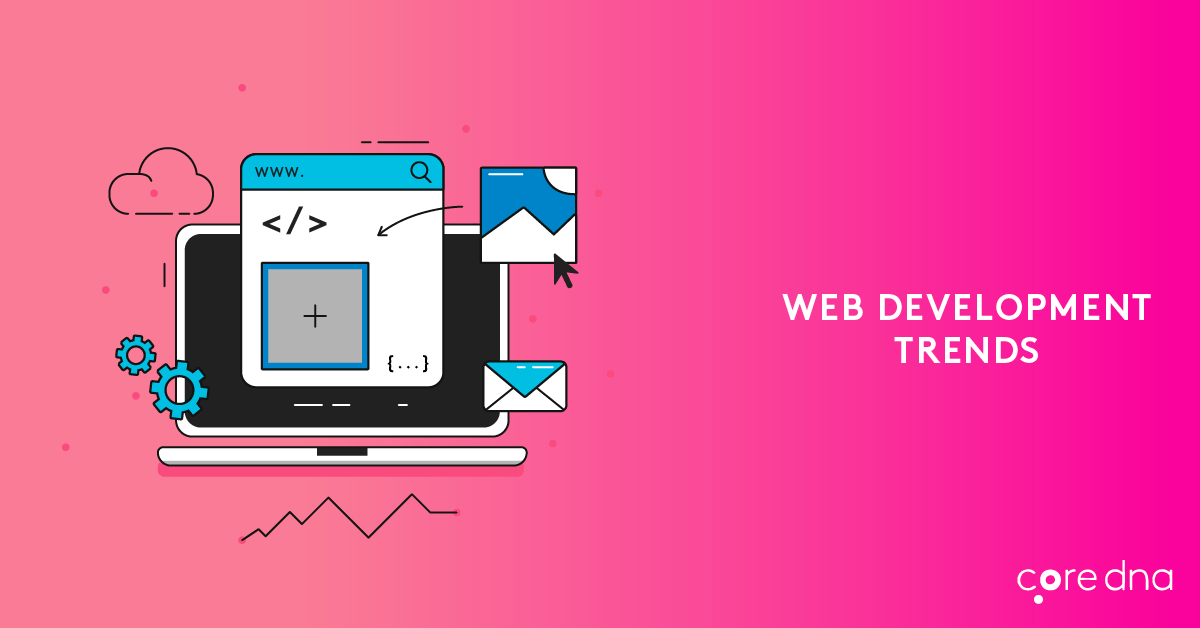Each year, new trends and technologies shape the environment that web developers find themselves in. One year is marked by static websites, another by mobile responsiveness, and another still by chatbots.
Keeping up with all of those changes is enough to discourage most companies. But that’s why you’re here. Because you refuse to be discouraged and you know the importance of preparing for the future. Since over half of business owners are planning to improve their website, it’s not unlikely that that’s the case with your own business. To keep up, you need to know the web development trends and technologies that will shape 2020.
Here are the top eight.
Here are the top 8 web development trends you need to look out for in 2020:
- Modular design and lower development costs
- Responsive design and the rise of mobile users
- Chatbots and customer support
- Accelerated mobile pages and load speed
- Voice search optimization
- API-first design and streamlined workloads
- Motion UI and suffering attention spans
- Artificial intelligence and cybersecurity
Download this guide as a PDF: Website development trends 2020
8 website development trends every CTO should keep an eye on in 2020
[Web development trend #1] Modular design and lower development costs
Modular design allows developers to reuse components and modules to create a web page rather than creating a web page using a restrictive template. Visually, modular design is a step up from templates. Developers can use it to create content blocks to display information is a powerful way.
However, creating a modular design web page is like building with a lego set. Each piece should interlock with one another without worrying how to rebuild the shape of the lego piece. Pattern Labs describes modular design as Russian nesting dolls.
“We should be able to put UI patterns inside each other like Russian nesting dolls. But thinking about Russian nesting dolls, every layer has its own thickness — the equivalent of padding and margin in web design. When a three-layer doll is put next to a seven-layer doll, the spacing in between is uneven. While it’s not an issue in particular with dolls, on web pages, that could lead to either uneven white space or multilevel CSS overrides.”
Of course, when each of these pieces is combined, developers build a web page that makes sense. This leads to faster and cheaper development but a similar end-goal product.
In photography, modular design looks like this.
All of the different pieces can be used for different scenarios. The same can be applied to website development. It’s cheaper, faster, and more flexible. For that reason, you’re probably going to see more of it come 2020.
[Web development trend #2] Responsive design and the rise of mobile users
Responsive design is becoming a must-have rather than a nice-to-have. In 2015, 35% of website traffic was served to mobile devices. Then, in 2016, that number was 43%. Now, in 2017, 50.3% of website traffic happened on a phone instead of a computer or tablet. That’s an increase in mobile traffic of 7% just from 2016 to 2017.
With all of that, then, it isn’t surprising that Google is going to release its mobile-first indexing during or after 2019 arrives officially.
But what is mobile-first indexing?
It’s simple. Here’s how Search Engine Watch explains it:
“Currently, Google looks at the desktop version of a site and then bases how it will rank the mobile site according to that information. Once this update rolls out, the opposite of that will happen. Google will begin looking at your mobile site and from that, will rank the desktop site.”
In other words, mobile websites will officially become the end-all of your rankings. So, how can developers prepare for this upcoming change? Well, many of you probably already are – if you have a mobile responsive website, you’re in the clear.
In the words of a Google representative…
“If you have a responsive site or a dynamic serving site where the primary content and markup is equivalent across mobile and desktop, you shouldn’t have to change anything.”
For those of you without a mobile-responsive website, it’s time to start playing catch up.
[Web development trend #3] Chatbots and customer support
57% of consumers appreciate chatbots for their instantaneity.
And Gartner predicts that over 85% of customer interactions will happen without a human on the business end by 2020. Similarly, according to TechEmergence, chatbots will become the number one application for consumers across all AI integrations in the next five year.
That’s a lot of hype.
And already, the chatbot is finding its place among customer service professionals. Which isn’t a big surprise. Businesses can save a lot of money by employing bots instead of humans. Collectively, around $23 billion in the customer service sector.
But what about consumers? Surely, they don’t want to talk to a bot instead of a human?
Well, the data might surprise you.
48% of consumers prefer to contact a company via live chat — for which chatbots are perfect — and a shocking 95% believe chatbots will be best used for customer service. Evidently, consumers are comfortable with chatbots and businesses are eager to use them.
[Web development trend #4] Accelerated mobile pages and load speed
With Accelerated Mobile Pages (AMP), Google is trying to encourage and enable business leaders to develop websites that load instantaneously and work smoothly on mobile devices.
As Google writes in a blog post regarding AMPs…
“We want web pages with rich content like video, animations, and graphics to work alongside smart ads and to load instantaneously. We also want the same code to work across multiple platforms and devices so that content can appear everywhere in an instant — no matter what type of phone, tablet or mobile device you’re using.”
At least, that’s the intention. But, of course, not everyone likes the idea. And those people aren’t entirely wrong in their opinion. AMPs are notoriously challenging to customize.
In the words of Search Engine Land:
“By its nature, AMP is restrictive. Imposing strict limits is how AMP ultimately increases speed and reduces bandwidth. If you’re thinking that restricting the HTML might restrict some functionality, you’re right.”
But despite those restrictions on creative-minded developers, the benefits of AMPs are real.The median load time, for instance, for content coded with AMP HTML is 0.7 seconds. Conversely, the median load time for non-AMP pages is 22 seconds.
That’s a massive difference.
Also, take a moment to consider the differences between the AMP version of this website on the right and the standard mobile version on the left.
Someone went ahead and ran speed tests on both of those versions of The Guardian. Here’s what they discovered. First, the mobile responsive version.
Then, the AMP.
The proof is in the pudding, and the pudding prefers AMPs. If AMP pages can load your website in 0.7 seconds rather than five, ten, 15, or even 20 seconds, then switching might make sense.
You should probably consider changing even if you just want to drive higher engagement and brand awareness with your website. They’ll likely become more common in 2020, and you’ll need to be prepared for their popularity one way or another.
[Web development trend #5] Voice search optimization
From 2008 to 2016, voice search queries multiplied by 35 times. And today, 19% of people use Siri at least once per day, and 55% of teens and 40% of adults use voice search on a daily basis. By 2020, 50% of search queries will be done with voice instead of text.
The point?
Voice search is a trend breaking into search engines everywhere. And technology like Siri on iPhone, Cortana on Android, Google Assistant from Google, and Alexa and Echo from Amazon aren’t only increasing how commonplace voice search is, it’s making consumers more comfortable with the feature.
In fact, two out of five people say voice-activated devices are essential to their lives.
And since consumers carry the final verdict as to which technologies survive and which thrive, voice search doesn’t seem to be going anywhere. What does this mean for web developers?
Two things.
First, it enhances the importance of making your website mobile responsive. 20% of mobile searches are voice searches, according to Google.
Second, as consumers become increasingly comfortable (and used to) using voice search to browse the internet, you might eventually want to integrate voice search internally on your website.
Fortunately, you can easily add a voice search recognition API to your website. And two of the world’s largest web browsers — Google Chrome and Firefox — support the technology. Which means that users don’t have to voice search to find your website and then text search on your website itself.
They can search for what they want on your domain, but, more importantly, they can search in the way they want (Side note: here’s how you can optimize your website for voice searches).
[Web development trend #6] API-first design and streamlined workloads
The more connected our world becomes the more APIs that each application ends up having. And with the rise of the IoT, our mobile devices, homes, cars, gaming systems, wearable tech, and laptops are all connected.
That offers a lot of convenience for the user. But all of those connections can get a bit dicey if the developer starts building the application in the wrong place. Traditionally, developers start with the user and build from there. They design the application and add in the appropriate APIs after the fact.
The back-end team starts working on an API, and once it’s finished, they give the API to front-end team for testing. At the same time, the front-end team works to build SDKs to test and double-check the API’s interactions.
There’s a problem, though. This means that front-end developers are waiting on back-end developers and the process often takes an inordinate amount of time and coordination.
With API-first design, however, developers start with the appropriate APIs and then “build the product on top of it”:
“By building on top of APIs with developers in mind, you and your developers are saving a lot of work while laying down the foundations for others to build on.”
If you want to get things done faster and without making front-end developers wait on back-end developers at every step of the way, a platform with headless content management capabilities – also known as an API-first solution – would be the way forward.
[Web development trend #7] Motion UI and suffering attention spans
The internet is massive. But you know that. What you might not know, though, is how that affects the average person’s attention span; some sources claim that the human attention span is worse than that of a goldfish.
And what better way to grab the attention of a user than with a captivating motion UI?
The Atlantic uses this on their Population Healthier page. As you scroll down the page, it changes and adapts to keep the visitor engaged.

Since attention spans are suffering, you’ll likely see more motion UI efforts on the part of developers to grab visitor attention and keep them engaged. Of course, we have yet to see how effective this strategy actually is. It might turn out to be a dud. But we won’t know until closer to 2020 or 2021.
[Web development trend #8] Artificial intelligence and cybersecurity
In 2020, the robots will likely make a big difference in the cybersecurity world.
As developers learn how to build artificial intelligence (AI) that can help with everything from customer support to predictive trends and image recognition, AI will become the future of cybersecurity.
In fact, Statista forecasts that businesses around the world will spend almost 2.5 billion dollars between 2016 and 2025 on artificial intelligence that’s meant to prevent cybersecurity threats.
Why are robots so helpful in the cybersecurity world, though?
For several reasons. Often, cybersecurity professionals can’t work to diffuse an attack until the damage has already been done. After all, even cybersecurity professionals have to sleep, eat, and go to the bathroom. The point is, these people aren’t always available.
In the words of Wired:
“These breaches are getting reported as historical events, long after something could have been done about it. That has got to change.”
Robots, however, are. And once they are created, you don’t have to pay them per hour, give them a 401K or offer lunch breaks. They can attack a problem the moment it occurs and will have a better chance of mitigating the damage done because of that.
A team at MIT already developed an artificial intelligence system to detect 85% of attacks before they even happen.
In 2020, AI will likely make cybersecurity cheaper and more efficient.
Over to you
If you’re like 57% of medium-sized businesses, you’re planning to upgrade your website to be faster, stronger, and more relevant. But before you do, pay attention to the web development trends and technologies creeping up in 2020.
To recap, here are the website development trends you need to keep an eye out:
- Responsive design and the rise of mobile users
- Chatbots and customer support
- AMP and its effect on load speed
- Voice search and how it impacts SEO
- API-first design and streamlined workloads
- Modular design and lower development costs
- Motion UI and how it helps increasing attention spans
- AI and cybersecurity
It doesn’t take long to develop a website. But it does to develop a great website.
Spend the extra time making these futuristic integrations so that when users stroll around the corner with a new set of expectations, you don’t look all that different from what they’re already familiar with.
source: https://www.coredna.com/blogs/web-development-trends
















